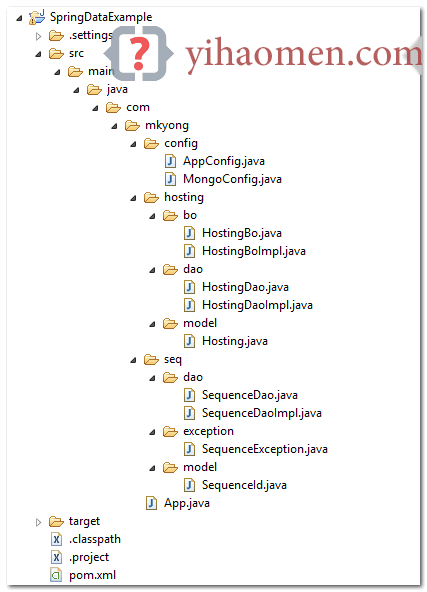Spring Data MongoDB Auto Sequence ID example
In this tutorial, we will show you how to generate an auto-incrementing sequence id in MongoDB + Spring Data environment.
Tools used in this project :
- Spring Data MongoDB 1.2.1.RELEASE
- MongoDB 2.4.5
- Eclipse 4.2
- Maven 3
At the end of this tutorial, if the collection name “hosting” is saved, a new auto-incrementing sequence id will be assigned. Below is the Java code snippet to generate the sequence id.
public long getNextSequenceId(String key) {
Query query = new Query(Criteria.where("_id").is(key));
Update update = new Update();
update.inc("seq", 1);
FindAndModifyOptions options = new FindAndModifyOptions();
options.returnNew(true);
SequenceId seqId =
mongoOperation.findAndModify(query, update, options, SequenceId.class);
return seqId.getSeq();
}
1. Project Structure
Review the project directory structure, a standard Maven project.

2. Maven Pom
In case you are interested at the project dependencies.
<project ...>
<properties>
<jdk.version>1.6</jdk.version>
<spring.version>3.2.2.RELEASE</spring.version>
<mongojavadriver.version>2.11.1</mongojavadriver.version>
<springdata.version>1.2.1.RELEASE</springdata.version>
</properties>
<dependencies>
<!-- Spring Core -->
<dependency>
<groupId>org.springframework</groupId>
<artifactId>spring-core</artifactId>
<version>${spring.version}</version>
</dependency>
<!-- need this for @Configuration -->
<dependency>
<groupId>cglib</groupId>
<artifactId>cglib</artifactId>
<version>2.2.2</version>
</dependency>
<!-- Spring Data for MongoDB -->
<dependency>
<groupId>org.springframework.data</groupId>
<artifactId>spring-data-mongodb</artifactId>
<version>${springdata.version}</version>
</dependency>
<!-- Java MongoDB Driver -->
<dependency>
<groupId>org.mongodb</groupId>
<artifactId>mongo-java-driver</artifactId>
<version>${mongojavadriver.version}</version>
</dependency>
</dependencies>
<build>
<finalName>SpringData</finalName>
<plugins>
<plugin>
<groupId>org.apache.maven.plugins</groupId>
<artifactId>maven-compiler-plugin</artifactId>
<version>2.3.2</version>
<configuration>
<source>${jdk.version}</source>
<target>${jdk.version}</target>
</configuration>
</plugin>
</plugins>
</build>
</project>
3. Sequence Collection
We create a collection name “sequence” to store the auto increase sequence id. Refer to the SequenceDaoImpl.java below, it shows you the code to generate the sequence id.
Create the “sequence” collection in your MongoDB first!
db.sequence.insert({_id: "hosting",seq: 0})
package com.mkyong.seq.model;
import org.springframework.data.annotation.Id;
import org.springframework.data.mongodb.core.mapping.Document;
@Document(collection = "sequence")
public class SequenceId {
@Id
private String id;
private long seq;
//get, set, toString...
package com.mkyong.seq.dao;
import com.mkyong.seq.exception.SequenceException;
public interface SequenceDao {
long getNextSequenceId(String key) throws SequenceException;
package com.mkyong.seq.dao;
import org.springframework.beans.factory.annotation.Autowired;
import org.springframework.data.mongodb.core.FindAndModifyOptions;
import org.springframework.data.mongodb.core.MongoOperations;
import org.springframework.data.mongodb.core.query.Criteria;
import org.springframework.data.mongodb.core.query.Query;
import org.springframework.data.mongodb.core.query.Update;
import org.springframework.stereotype.Repository;
import com.mkyong.seq.exception.SequenceException;
import com.mkyong.seq.model.SequenceId;
@Repository
public class SequenceDaoImpl implements SequenceDao {
@Autowired
private MongoOperations mongoOperation;
@Override
public long getNextSequenceId(String key) throws SequenceException {
//get sequence id
Query query = new Query(Criteria.where("_id").is(key));
//increase sequence id by 1
Update update = new Update();
update.inc("seq", 1);
//return new increased id
FindAndModifyOptions options = new FindAndModifyOptions();
options.returnNew(true);
//this is the magic happened.
SequenceId seqId =
mongoOperation.findAndModify(query, update, options, SequenceId.class);
//if no id, throws SequenceException
//optional, just a way to tell user when the sequence id is failed to generate.
if (seqId == null) {
throw new SequenceException("Unable to get sequence id for key : " + key);
return seqId.getSeq();
package com.mkyong.seq.exception;
public class SequenceException extends RuntimeException {
private static final long serialVersionUID = 1L;
private String errCode;
private String errMsg;
//get, set...
public SequenceException(String errMsg) {
this.errMsg = errMsg;
4. Get the Sequence ID
To get the sequence id, uses sequenceDao.getNextSequenceId("key").
package com.mkyong.hosting.bo;
import com.mkyong.seq.exception.SequenceException;
public interface HostingBo {
void save(String name) throws SequenceException;
package com.mkyong.hosting.bo;
import org.springframework.beans.factory.annotation.Autowired;
import org.springframework.stereotype.Service;
import com.mkyong.hosting.dao.HostingDao;
import com.mkyong.hosting.model.Hosting;
import com.mkyong.seq.dao.SequenceDao;
import com.mkyong.seq.exception.SequenceException;
@Service
public class HostingBoImpl implements HostingBo {
private static final String HOSTING_SEQ_KEY = "hosting";
@Autowired
private SequenceDao sequenceDao;
@Autowired
private HostingDao hostingDao;
@Override
public void save(String name) throws SequenceException {
Hosting hosting = new Hosting();
hosting.setId(sequenceDao.getNextSequenceId(HOSTING_SEQ_KEY));
hosting.setName(name);
hostingDao.save(hosting);
System.out.println(hosting);
5. Testing
Run a simple test.
package com.mkyong;
import org.springframework.context.ApplicationContext;
import org.springframework.context.annotation.AnnotationConfigApplicationContext;
import com.mkyong.config.AppConfig;
import com.mkyong.hosting.bo.HostingBo;
import com.mkyong.seq.exception.SequenceException;
public class App {
public static void main(String[] args) {
ApplicationContext ctx =
new AnnotationConfigApplicationContext(AppConfig.class);
HostingBo hostingBo = (HostingBo) ctx.getBean("hostingBoImpl");
try {
hostingBo.save("cloud.google.com");
hostingBo.save("heroku.com");
hostingBo.save("cloudbees.com");
} catch (SequenceException e) {
System.out.println(e.getErrMsg());
Output – Java console
Hosting [id=1, name=cloud.google.com] Hosting [id=2, name=heroku.com] Hosting [id=3, name=cloudbees.com]
MongoDB console.
>mongo
> db.sequence.find()
{ "_id" : "hosting", "seq" : 3 }
> db.hosting.find()
{ "_id" : NumberLong(1), "_class" : "com.mkyong.hosting.model.Hosting", "name" : "cloud.google.com" }
{ "_id" : NumberLong(2), "_class" : "com.mkyong.hosting.model.Hosting", "name" : "heroku.com" }
{ "_id" : NumberLong(3), "_class" : "com.mkyong.hosting.model.Hosting", "name" : "cloudbees.com" }
>
6. FAQs
Q. SequenceException – Unable to get sequence id for key : hosting ?
A. Remember to create the “sequence” collection!
db.sequence.insert({_id: "hosting",seq: 0})
References
From:一号门
Previous:Find out your Java heap memory size

COMMENTS